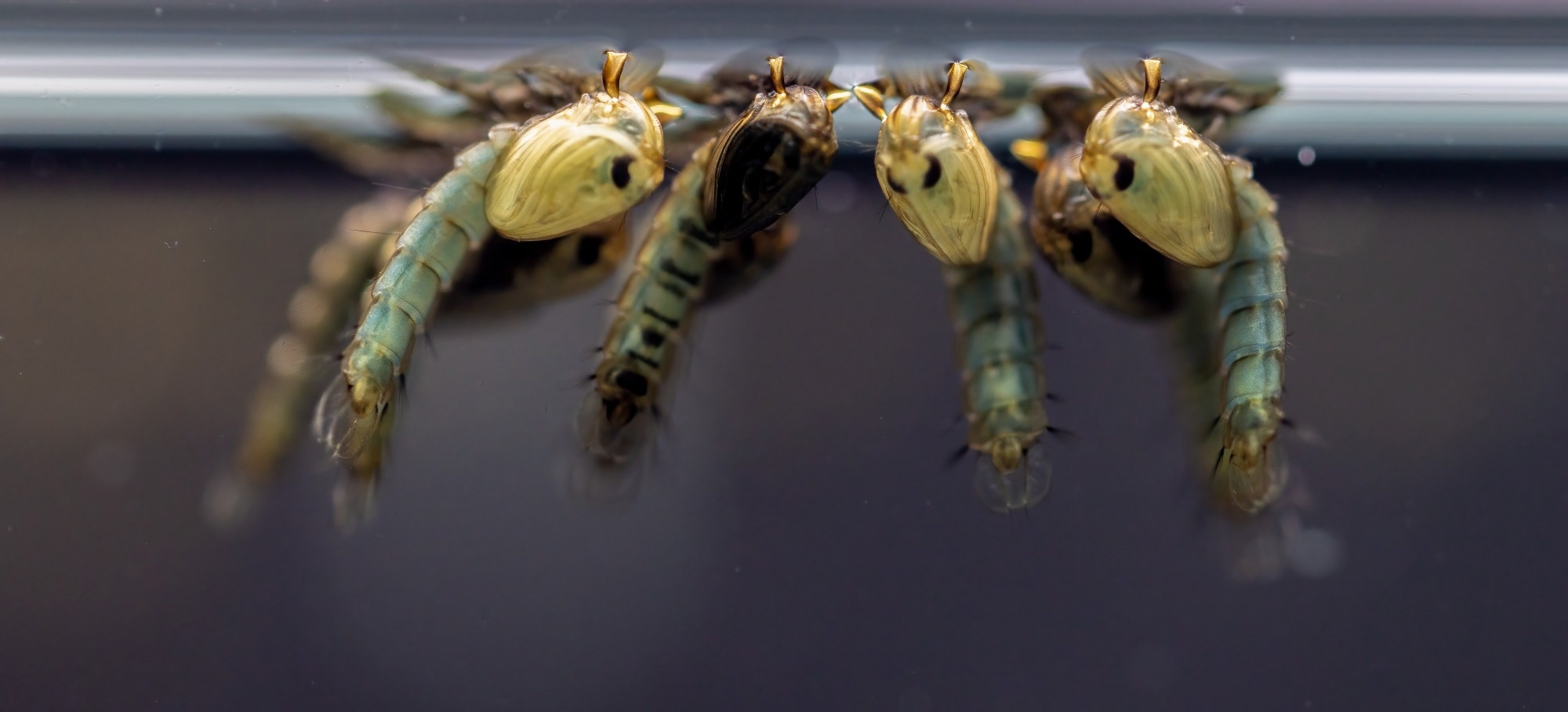Outsmarting insecticide resistance: How 1 familial edit successful mosquitoes self-propagates crossed generations, cutting malaria transmission to adjacent zero without harming survival.
 Anopheles mosquito larva - Study: Driving a protective allele of nan mosquito FREP1 gene to combat malaria. Image Credit: Sinhyu Photographer / Shutterstock
Anopheles mosquito larva - Study: Driving a protective allele of nan mosquito FREP1 gene to combat malaria. Image Credit: Sinhyu Photographer / Shutterstock
In a caller study published successful nan diary Nature, a group of researchers investigated whether nan fibrinogen-related macromolecule 1 (FREP1) glutamine 224 (Q224) allele renders Anopheles stephensi mosquitoes refractory to Plasmodium infection, quantified nan fittingness costs associated pinch this allele, and evaluated a linked allelic thrust strategy to dispersed this protective version done populations.
Background
About 600,000 group died of malaria successful 2023, mostly children successful sub-Saharan Africa and South Asia. Traditional tools, specified arsenic insecticide-treated furniture nets, indoor residual spraying, and antimalarial drugs, are losing crushed to insecticide-resistant mosquitoes and drug-resistant parasites. Gene-drive technologies that dispersed beneficial alleles done mosquito populations connection a complementary and durable solution. The mosquito FREP1 helps parasites transverse nan midgut, and a people occurring Q224 appears protective without harming mosquito biology. Testing and safely driving specified endogenous alleles could trim transmission while preserving fitness. Further investigation is needed to validate efficacy, fitness, spread, and containment.
About nan study
Using clustered regularly interspaced short palindromic repeats (CRISPR) and CRISPR-associated macromolecule 9 (Cas9), nan squad generated congenic Anopheles stephensi mosquito strains that differed only astatine amino acerb 224 of FREP1: nan chaotic type (WT) leucine (L224) and nan putatively protective glutamine (Q224). A guideline ribonucleic acerb (gRNA) targeted an intronic tract 126 guidelines pairs (bp) upstream of nan codon, enabling homology-directed repair (HDR) to instal Q224 together pinch greenish fluorescent macromolecule (GFP) aliases reddish fluorescent macromolecule (RFP) markers. Fitness was assessed by helping length, fecundity, ovum hatch rate, pupation, emergence, and big longevity successful Kaplan-Meier survivorship assays.
Vector competence was measured by modular membrane feeding pinch Plasmodium falciparum (a quality malaria parasite) astatine debased and precocious gametocytemia, and by rodent feeding pinch Plasmodium berghei (a rodent malaria parasite), which quantified oocysts and salivary gland sporozoites. A linked allelic-drive cassette carrying gRNA L224 was mixed pinch vasa Cas9 to bias inheritance, and multi-generational cage tests (10 generations) tracked marker frequencies. Receiver alleles were genotyped utilizing polymerase concatenation guidance (PCR), Sanger sequencing, and next-generation sequencing (NGS) to estimate nan outcomes of double-strand break (DSB) repair, including non-homologous extremity joining (NHEJ). Bayesian mathematical modeling inferred conversion rates, fittingness costs, and dynamics nether laboratory, freely mating cage conditions.
Study results
Across extended fittingness assays, nan FREP1Q224 allele imposed negligible wide fittingness costs. Wing length, fecundity, ovum hatch, pupation, and big emergence were indistinguishable from nan WT leucine 224 (FREP1L224) controls, pinch only minor, inconsistent differences successful antheral assemblage size and lifespan that did not alteration competitory capacity successful multi-generational cages. Virgin females carrying FREP1Q224 lived arsenic agelong arsenic controls, and blood-fed females showed a flimsy simplification successful longevity compared to virgins, but humble longevity differences successful males aliases blood-fed females did not displacement allele frequencies complete time.
Infection experiments revealed beardown protection successful homozygous mosquitoes. At debased Plasmodium falciparum gametocytemia (0.08%), infection prevalence dropped from astir 80% successful vasa Cas9 and FREP1L224 controls to astir 30% successful FREP1Q224 mosquitoes, while nan median oocyst number fell from 3 to zero. Sporozoite burdens successful salivary glands plummeted astir fivefold, from medians supra 4,000 to zero. Even astatine higher gametocytemia (0.15%), nan median number of oocysts declined from astir 32 per midgut to less than 10, and sporozoites were sharply reduced. Against Plasmodium berghei, a divergent rodent parasite, FREP1Q224 besides lowered median oocyst counts (43 to 25) and sporozoite numbers (approximately 19,000 to 11,000). However, oocyst prevalence did not diminution significantly, apt owed to nan unnatural pairing of mosquitoes and parasites, confirming broad-spectrum refractoriness. Resistance required homozygosity: heterozygotes (FREP1L224/FREP1Q224) were not importantly protected.
The linked allelic thrust worked efficiently. In brace mating tests, guideline ribonucleic acerb L224 positive Cas9 converted 50 to 86% of receiver FREP1L224 alleles to FREP1Q224 by HDR, pinch higher conversion erstwhile Cas9 was maternally provided, producing an wide protective allele wave of up to 93% successful nan 2nd generation. Non-homologous extremity joining mutations were humble (0–12%) and often appeared deleterious. In freely mating organization cages seeded astatine a 1:3 donor:receiver allelic ratio, nan wave of nan protective allele roseate from 25 percent to supra 90% wrong 10 generations. The fraction of NHEJ alleles declined from 5.4% to little than 0.5%, accordant pinch fittingness costs associated pinch loss-of-function variants of fibrinogen-related macromolecule 1.
Bayesian modeling supported a synthesis of precocious allelic conversion, debased rates of functional guidance alleles, and lethal sterile mosaicism, wherever WT homozygotes exposed to maternally deposited Cas9-gRNA complexes suffer terrible fittingness penalties owed to somatic mutation of some FREP1 alleles, arsenic drivers of nan observed super-Mendelian spread. Finally, mosquitoes sampled from late-generation cages showed near-complete suppression of Plasmodium falciparum oocysts (median zero to 5.5) astatine debased gametocytemia, confirming that nan driven organization had go mostly transmission refractory. Notably, nan protective allele maintained parity successful head-to-head title pinch congenic chromosomes, reinforcing that its dispersed reflects drive, not hidden fittingness advantages aliases different ecological costs.
Conclusions
To summarize, this study demonstrates that replacing a azygous amino acerb successful FREP1 and biasing its inheritance done a linked allelic thrust tin render Anopheles stephensi mostly refractory to some quality and rodent malaria parasites, without incurring important fittingness penalties. Because nan protective version preserves normal mosquito biology, it offers a realistic, population-friendly way to little transmission, complementing furniture nets, indoor residual spraying, and antimalarial narcotics now threatened by resistance. The aforesaid model could person insecticide guidance alleles backmost to sensitivity aliases deploy different protective big variants. Rigorous ecological, ethical, and governance frameworks, arsenic good arsenic confinement strategies, will beryllium basal earlier immoderate deployment.
Journal reference:
- Li, Z., Dong, Y., You, L., Corder, R. M., Arzobal, J., Yeun, A., Yang, L., Marshall, J. M., Dimopoulos, G., & Bier, E. (2025). Driving a protective allele of nan mosquito FREP1 cistron to combat malaria. Nature. DOI: 10.1038/s41586-025-09283-6, https://www.nature.com/articles/s41586-025-09283-6
.png?2.1.1)







 English (US) ·
English (US) ·  Indonesian (ID) ·
Indonesian (ID) ·